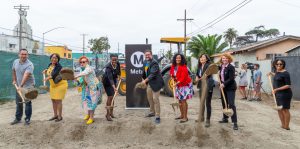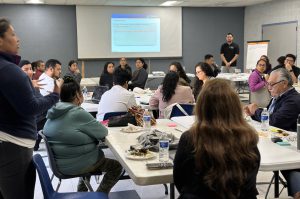
Celebrating 10 Years of SLATE-Z
Celebrating 10 Years of SLATE-Z A Legacy of Cultural Richness South Los Angeles has long been a place of cultural vibrancy, tracing its roots to
Variable Definitions:
Labor Force Participation Rate: The percentage of the population over the age of 16 that is in the civilian labor force, meaning they are either employed or unemployed and looking for work
Female Labor Force Participation Rate: The percentage of the female population over the age of 16 that is in the civilian labor force, meaning they are either employed or unemployed and looking for work
Male Labor Force Participation Rate: The percentage of the male population over the age of 16 that is in the civilian labor force, meaning they are either employed or unemployed and looking for work
Source:
American Community Survey, 5-year estimates, Table B23001
Years Available:
2010 – 2023
*Note: Each year of available data shown above is a 5-year estimate, or an average of data collected over a five year period. 5-year estimates are used to increase the reliability of the data at small geographies like neighborhoods and census tracts. The years shown on the NDSC map represent the final year of the five year average (e.g. “2010” represents 2006-2010 data, “2011” represents 2007-2011 data, and so on). For the most impactful comparison of data over time, the ACS recommends comparing non-overlapping years (e.g. 2010-14 with 2015-19).
Labor Force Participation Rates
The term civilian labor force encompasses all people of working age (16 and over) who live in the United States, including employed people and unemployed people looking for work. The labor force does not include “discouraged workers,” people who are unemployed but have given up looking for work, or active military members.
It is important to understand the proportion of a community that is participating in the labor force, either actively working or looking for a job, in order to understand how a community is connected to the broader economy. Further, the relative size of a community’s labor force indicates its economic potential, helpful for considering how much economic production is actually taking place within an area. Labor force participation is also helpful in designing government programs, maximizing social services surrounding employment, and evaluating the economic needs of people in a community.
Unemployment Rate
The unemployment rate represents the percentage of the labor force that is unemployed and looking for work.
Measuring employment status by sex can shed light on the different challenges potential workers may face due to their gender or sex. These obstacles may refer to the hiring processes, such as discriminatory hiring practices, or household and child-rearing responsibilities that disproportionately fall on women.
Despite having higher levels of attained education, women in Los Angeles County face lower median earnings, higher unemployment rates, and higher poverty rates than men (MSMU, 2023). Highlighting the employment status by sex in LA communities can help prompt policies or programs that seek to reduce differences in wages and employment security for the female population.
Written by Justin Culetu
Citations
Mount Saint Mary’s University. (2023). Report on the Status of Women in Los Angeles County. Los Angeles County Commission for Women. https://file.lacounty.gov/SDSInter/bos/commissionpublications/report/1137865_MSMUCommissionReport23R5.pdf

Celebrating 10 Years of SLATE-Z A Legacy of Cultural Richness South Los Angeles has long been a place of cultural vibrancy, tracing its roots to

Advancing a Collaborative Agenda in Southeast LA In 2022, the California Community Foundation (CCF) launched the Regional Recovery Hub to strengthen place-based coordination in Los Angeles County

In 2022, the California Community Foundation (CCF) launched the Regional Recovery Hub to strengthen place-based coordination in Los Angeles County regions that were most heavily impacted by
